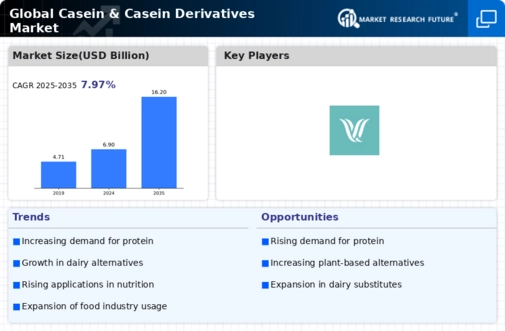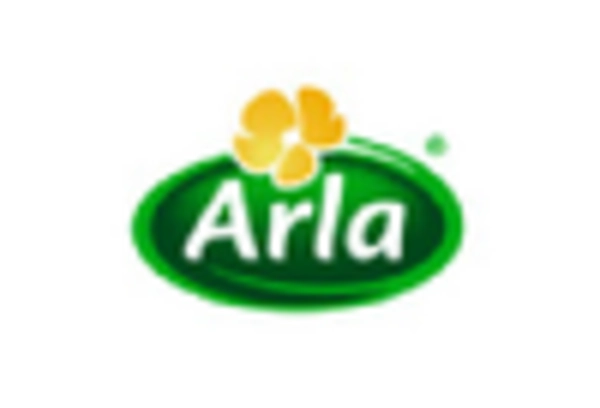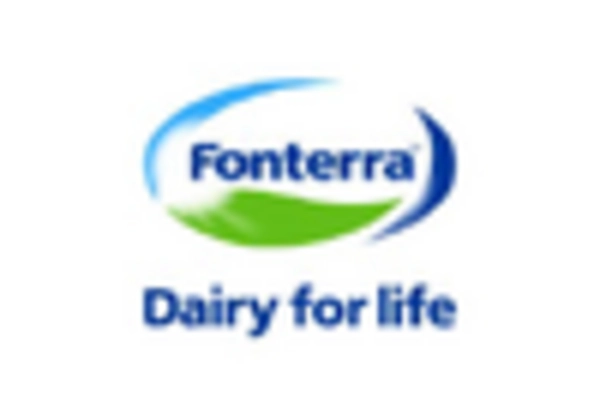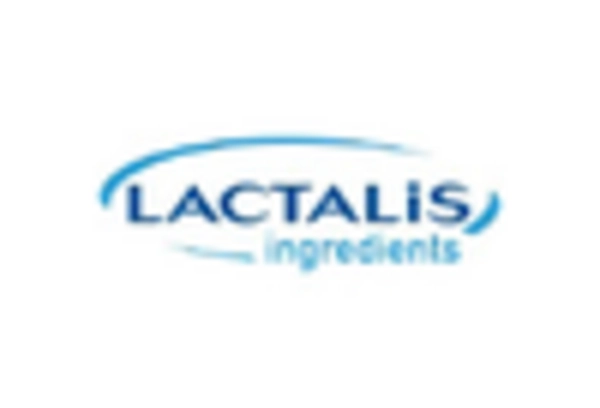Market Analysis
In-depth Analysis of Casein Derivatives Market Industry Landscape
The market dynamics of the casein and casein derivatives market are influenced by a variety of factors that collectively shape its growth and evolution. Casein, a protein found in milk, is widely utilized in various industries, and its derivatives find applications in food, pharmaceuticals, and cosmetics. One of the primary drivers of this market is the increasing demand for protein-rich ingredients and the versatile functional properties of casein. As consumers become more health-conscious, the demand for protein-enhanced products, including nutritional supplements and protein fortification in food and beverages, has witnessed significant growth. The remarkable expansion of the casein and casein derivatives market is primarily fueled by a surge in the demand for dietary supplements, coupled with the widespread growth of leading dairy-based vendors. Additionally, the market is propelled by an increasing need for industrial products and a rising consumer inclination towards protein-rich energy bars and caffeinated beverages. The escalating demand for casein and its derivatives is further augmented by the growing popularity of these products in the global market.
Moreover, the market experiences a notable boost due to the rising popularity of halal cosmetics, particularly in Middle Eastern countries such as Iran, Saudi Arabia, and Jordan. This surge in demand for halal cosmetics contributes significantly to the overall growth of the casein and casein derivatives market. As a result, the industry is witnessing a dynamic expansion driven by diverse factors ranging from dietary preferences to the rising significance of halal products in specific regional markets. The versatile applications of casein and its derivatives across various sectors underscore their integral role in meeting evolving consumer demands and preferences. Global dairy industry dynamics and milk production significantly impact the casein and casein derivatives market. The availability and pricing of casein are influenced by factors such as milk production volumes, seasonal variations, and the geographical concentration of dairy farming. Fluctuations in milk prices and supply can impact the overall cost structure of casein production, introducing an element of variability into the market.
Changing consumer preferences and dietary trends contribute to the market dynamics of casein and its derivatives. As the popularity of high-protein diets rises, casein, with its slow-digesting and sustained-release properties, becomes a preferred choice among fitness enthusiasts and individuals aiming for muscle maintenance or growth. Additionally, the functional attributes of casein, such as its emulsifying and gelling properties, make it a valuable ingredient in the food industry for applications like cheese, yogurts, and bakery products.
Technological advancements in extraction processes and manufacturing impact the casein market. Continuous innovations in processing methods ensure the efficient isolation of casein from milk, enhancing both the purity and functionality of the final product. Advanced manufacturing technologies contribute to cost-effectiveness, scalability, and the development of specialized casein derivatives to meet the diverse needs of different industries.
Regulatory considerations and quality standards play a crucial role in shaping the casein and casein derivatives market dynamics. Compliance with regulations related to food safety, nutritional labeling, and quality control is essential for market participants. Adherence to international standards ensures that casein products meet the expectations of a global consumer base, contributing to consumer trust and market competitiveness.
Consumer education and marketing strategies are significant contributors to market dynamics. Brands often highlight the nutritional benefits of casein, emphasizing its protein content and slow-release properties. Marketing efforts that communicate the applications of casein in sports nutrition, functional foods, and culinary products influence consumer perceptions and drive demand for casein-containing products.
Economic factors, such as disposable income and purchasing power, contribute to the dynamics of the casein and casein derivatives market. The affordability and perceived value of casein products impact consumer choices. Economic fluctuations can influence consumer spending patterns, potentially affecting the demand for premium or value-oriented casein-containing products.
Retail and distribution channels are crucial elements shaping market dynamics. The availability of casein products in supermarkets, health food stores, and online platforms influences consumer accessibility. Effective distribution networks and strategic partnerships with retailers ensure a wider market reach, enabling casein manufacturers to tap into various consumer segments and capitalize on emerging trends.
Industry collaborations and partnerships within the food, pharmaceutical, and cosmetic sectors contribute to market dynamics. Ingredient suppliers, manufacturers, and research institutions often collaborate to develop innovative formulations that incorporate casein derivatives. These collaborations foster the creation of new products and expand the application scope of casein, contributing to a dynamic and competitive market landscape.
The competitive landscape within the casein and casein derivatives market plays a crucial role in shaping its dynamics. Market players engage in product differentiation, branding, and marketing strategies to gain a competitive edge. Mergers, acquisitions, and partnerships within the industry can reshape the market by consolidating market share, introducing new capabilities, or expanding product portfolios.









Leave a Comment